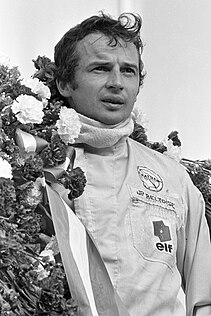
Jean-Pierre Maurice Georges Beltoise was a French Grand Prix motorcycle road racer and Formula One driver who raced for the Matra and BRM teams. He competed in 88 Grands Prix achieving a single victory, at the 1972 Monaco Grand Prix, and a total of eight podium finishes.

Maria Grazia "Lella" Lombardi was a racing driver from Italy.
Lyncar was a Formula One constructor from the United Kingdom. They participated in only two grands prix, the 1974 and 1975 British Grands Prix, entering a total of two cars.

Chris Amon Racing, also known simply as Amon, was a Formula One team established by New Zealand driver Chris Amon. It competed as a privateer team in the 1966 Italian Grand Prix, then as a constructor in its own right in the 1974 Formula One season.
Embassy Racing With Graham Hill, commonly abbreviated to Embassy Hill, was a short-lived Formula One team started by two-time Formula One World Champion Graham Hill. The team debuted in 1973 with a customer Shadow DN1 car, and began racing as a constructor with its own chassis in 1975. The team had limited success in three seasons of racing, but everything was cut short by the death of Hill, Tony Brise and some of the team's top personnel in the crash of a light aircraft in the autumn before the 1976 season. The team was sponsored by Imperial Tobacco's Embassy cigarette brand and ran under various names during its time.
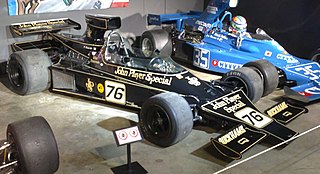
The Lotus 76 is a Formula One car designed by Colin Chapman, Tony Rudd and Ralph Bellamy and used by Team Lotus in the 1974 Formula One season.
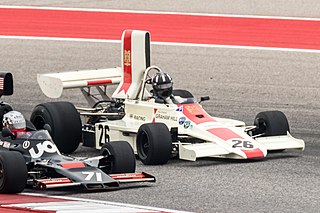
The Hill GH1 was a Formula One car used by Embassy Hill during the 1975 Formula One season. It was designed by Andy Smallman. The car was initially designated as the Lola T371, but when Smallman left Lola to work full-time for Embassy Hill it was renamed as the Hill GH1. GH1 cars participated in 12 World Championship Grands Prix in 1975, with 21 entries in total using six different drivers. Two points finishes yielded 11th place in the World Constructors' Championship, with three points.
The Brabham BT48 was a Formula One racing car designed by Gordon Murray and raced by the Brabham team. The car, powered by a 12-cylinder Alfa Romeo engine, competed in the 1979 Formula One season. The intended plan was to run the BT47 but the FIA outlawed it because it had a Chaparral 2J-type box rear end with twin variable geometry fans on the rear to maximize ground effect, so Murray designed the BT48 instead.

The Hesketh 308C was a Formula One racing car designed by Harvey Postlethwaite and used by Hesketh Racing in the latter stages of the 1975 Formula One season. The car featured the rubber suspension which Postlethwaite had pioneered on the preceding 308B model and a Ford-Cosworth DFV engine. In 1976, the car was acquired by Wolf–Williams Racing and rebranded as the Wolf–Williams FW05.
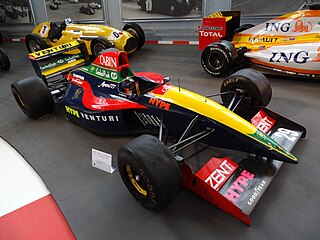
The Venturi LC92 was a Formula One racing car designed by Robin Herd, Michel Tétu and Tino Belli for the 1992 Formula One season. Built to replace the Lola LC91 used in the previous season, after Larrousse had ended their agreement with Lola, the LC92 used a 3.5-litre Lamborghini 3512 V12 engine. It was the first car that Larrousse had built since Venturi had bought a controlling stake in the team, with Bertrand Gachot and Ukyo Katayama being selected to drive the car. Although the LC92 finished more races than its predecessor, it was no quicker, and Gachot scored the team's only point of the season at the 1992 Monaco Grand Prix. After Venturi sold their stake in Larrousse at the end of the season, the LC92 was replaced by the Larrousse LH93, which was marginally more successful.

The Tyrrell 002 is a Formula One racing car which was designed for the 1971 and 1972 Formula One seasons by Tyrrell's Chief Designer, Derek Gardner. It was essentially the same design as the Tyrrell 001, but incorporated some detail changes, and 002 were built with longer monocoques, as François Cevert was taller than Jackie Stewart.

The Surtees TS7 was a Formula One car used by Surtees during the 1970 and 1971 Formula One seasons. It was designed by John Surtees, Shahab Ahmed and Peter Connew.
The Lola LC87 is a Formula One car that the Larrousse team used to compete in 1987, the team's first season in Formula One.

The Williams FW was a Formula One car used by Frank Williams Racing Cars during the 1973, 1974 and 1975 seasons. It was designed by John Clarke.

The Williams FW04 was a Formula One car used by Frank Williams Racing Cars during the 1975 season and Wolf–Williams Racing during the 1976 season. The car was a development of the Williams FW and two were built. Although not a particularly successful car, an FW04 finished second at the 1975 German Grand Prix.

The Fittipaldi FD was a series of Formula One chassis designed by Richard Divila and used by Fittipaldi Automotive in the 1975, 1976 and 1977 seasons. The initial chassis was designated Fittipaldi FD01 and there were three minor developments designated, Fittipaldi FD02, Fittipaldi FD03 and Fittipaldi FD04 respectively. FD series cars competed in 37 races making 43 individual entries in total. The chassis achieved a best finish of fourth place at both the 1977 Argentine and Brazilian Grands Prix driven on each occasion by former World Champion and joint team-owner Emerson Fittipaldi. It scored a total of 11 World Championship points.
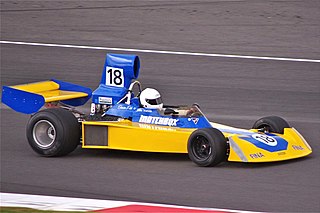
The Surtees TS16 was a Formula One car used by Surtees during the 1974, 1975 and 1976 Formula One seasons. It was designed by John Surtees.

The Surtees TS9 was a Formula One car used by Surtees during the 1971, 1972 and 1973 Formula One seasons. It was designed by John Surtees and Peter Connew.

The Penske PC1 was a Formula One racing car developed and raced by Penske Racing during the 1974 and 1975 Formula One seasons. The car was designed by Geoff Ferris, and was raced by drivers Mark Donohue and John Watson. The PC1 entered and competed in 12 Grands Prix, and was replaced by the Penske PC3 in the 1976 season.

The Tyrrell 007 is a Formula One racing car, designed by Tyrrell's Chief Designer, Derek Gardner. It was used in the 1974, 1975, 1976 and 1977 Formula One seasons.

















